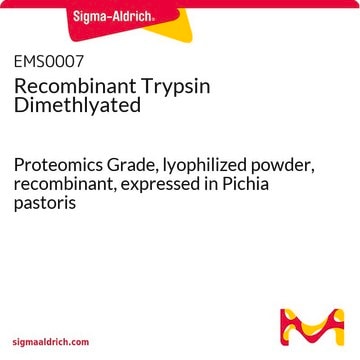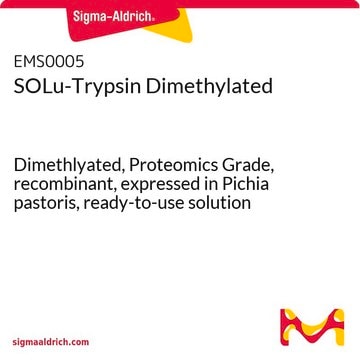TRYPSEQ-RO
Roche
Trypsin Sequencing Grade
from bovine pancreas
Synonim(y):
trypsin
About This Item
Polecane produkty
pochodzenie biologiczne
bovine pancreas
Poziom jakości
Postać
lyophilized (salt-free)
aktywność właściwa
≥80 units/mg protein
masa cząsteczkowa
Mr 23.5 kDa
opakowanie
pkg of 4 × 100 μg (11047841001)
pkg of 4 × 25 μg (11418475001)
producent / nazwa handlowa
Roche
optymalne pH
8.0
temp. przechowywania
2-8°C
Powiązane kategorie
Opis ogólny
Specyficzność
Specificity (HPLC, with Insulin Box):
Cleavage after 1 hour: ≥90%;
Unspecific cleavage products after 18 hours: ≤10%
Zastosowanie
The enzyme is used for protein-structure elucidation, tryptic mapping, fingerprinting, sequence analysis, and translocation studies. Trypsin Sequencing Grade generates glycopeptides from purified glycoproteins and is suited for the digestion of proteins in polyacrylamide gels.
Jakość
Uwaga dotycząca przygotowania
Working concentration: 1/100 to 1/20 of the protein by weight (in solution); 1-5 μg/100 μl (for in-gel digest)
Storage conditions (working solution): A solution in 0.01% trifluoroacetic acid (TFA), (v/v) or 1 mM HCl may be used for one week at maximum, if stored at 2 to 8 °C. By incubation of proteins in solution at neutral to slightly basic pH-values partial autolysis might occur. For this application, Roche recommends Trypsin, Modified, Sequencing Grade.
Rekonstytucja
Inne uwagi
Hasło ostrzegawcze
Danger
Zwroty wskazujące rodzaj zagrożenia
Zwroty wskazujące środki ostrożności
Klasyfikacja zagrożeń
Eye Irrit. 2 - Resp. Sens. 1 - Skin Irrit. 2 - STOT SE 3
Organy docelowe
Respiratory system
Kod klasy składowania
11 - Combustible Solids
Klasa zagrożenia wodnego (WGK)
WGK 1
Temperatura zapłonu (°F)
does not flash
Temperatura zapłonu (°C)
does not flash
Certyfikaty analizy (CoA)
Poszukaj Certyfikaty analizy (CoA), wpisując numer partii/serii produktów. Numery serii i partii można znaleźć na etykiecie produktu po słowach „seria” lub „partia”.
Masz już ten produkt?
Dokumenty związane z niedawno zakupionymi produktami zostały zamieszczone w Bibliotece dokumentów.
Klienci oglądali również te produkty
Nasz zespół naukowców ma doświadczenie we wszystkich obszarach badań, w tym w naukach przyrodniczych, materiałoznawstwie, syntezie chemicznej, chromatografii, analityce i wielu innych dziedzinach.
Skontaktuj się z zespołem ds. pomocy technicznej












